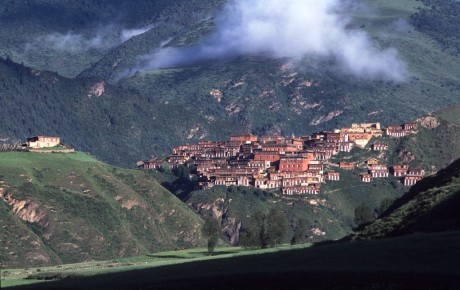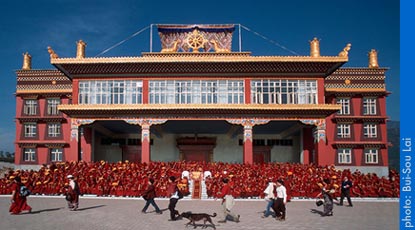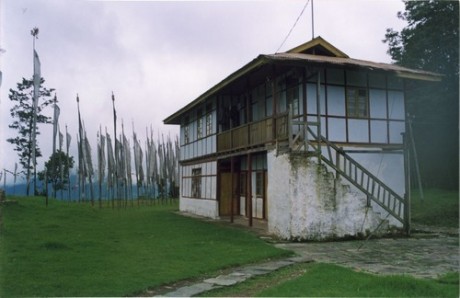Monastic Fund
From the time of Shakyamuni Buddha until the present day, an unbroken succession of great beings have achieved enlightenment and dedicated themselves to teaching this path to others. Monasteries and Buddhist institutes produce teachers who keep the traditions of Buddhism alive. To preserve Buddhism as a living tradition, Khyentse Foundation supports a stable monastic environment with a strong emphasis on higher philosophical studies and long-term retreat.
Khyentse Foundation has established a US$5 million endowment to fund the maintenance and upkeep of Rinpoche’s monastic colleges in Tibet, India, and Bhutan. Currently the Foundation’s support concentrates on two of those institutes—Dzongsar Monastery/Dzongsar Khamje Shedra in Eastern Tibet and Dzongsar Khyentse Chökyi Lodrö Institute in India. More than a thousand monks, nuns, and lay students rely on the support system established by the Foundation for their basic needs, including food, robes, texts, and medical care, in addition to free tuition. These institutions provide the necessary training for young lamas to become qualified dharma teachers. These young lamas are the future of dharma study; it is up to them to ensure that Buddhism’s academic tradition continues.
The five monastic colleges under Rinpoche’s patronage are:
- Dzongsar Monastery/Dzongsar Khamje Shedra, Derge, Eastern Tibet
- Dzongsar Khyentse Chökyi Lodrö Institute, Chauntra, Himachal Pradesh, India
- Gyalshing Retreat Center, Sikkim, India
- Chökyi Gyamstso Institute for the Study of Buddhist Philosophy, Dewathang, Bhutan
- Bartsham Dharma Center, Bartsham Drubdra, Bhutan
Innovation and organization are a big part of our work at these monasteries. The Dzongsar Institutes maintain traditional academic excellence while expanding their curricula in ways that are gaining international recognition. Rinpoche has invited lecturers to present courses on subjects such as the global economy, history, and western philosophy. Plans are in place to produce Buddhist teacher-scholars who can speak English and Chinese and who are computer literate. A new exchange program has been established between the Dzongsar Institutes and major universities in the west, beginning with George Washington University in Washington D.C. In addition, new bookkeeping practices have been introduced to ensure that all KF funds are properly used and accounted for.
Dzongsar Khamje Shedra
Derge, Eastern Tibet

Dzongsar Khamje Shedra was founded in 1871 on a plain below Dzongsar Monastery in eastern Tibet. It was designed in the form of a drawn bow and arrow, attributes of Manjushri, the Buddha of Wisdom. The great 18th century masters Jamyang Khyentse Wangpo and Chökgyur Lingpa prophesied that a college on this location would greatly benefit the Buddhist teachings. The original structure was expanded by Jamyang Khyentse Chöki Lodrö in 1918.
The Shedra was destroyed in the 1960s, but reconstruction was begun in 1986, at the behest of the late Panchen Lama. Sponsored by Dzongsar Khyentse Rinpoche, the basic structure of a college was completed in 1989. At present, the college has over 410 students. The current curriculum, which was set by Jamyang Khyentse Chökyi Lodrö, includes study of the Buddhist scriptures such as the tripitaka, the shastras, the tantras, and the sciences of poetry, astrology, and medicine. Many graduates of this college have become teachers themselves. In addition to the shedra there are two retreat centers at Dzongsar Monastery housing over 350 monks and nuns on long-term retreat.
Dzongsar Khyentse Chökyi Lodrö Institute
Chauntra, Himachal Pradesh, India

Under the guidance and support of its principal, the venerable Khenpo Kunga Wangchuk, Dzongsar Institute relocated from Bir to Chauntra, Himachal Pradesh, India in 2004 and was renamed Dzongsar Khyentse Chökyi Lodrö Institute (DKCL). His Holiness the Dalai Lama presided over the three-day inauguration.
The DKCL complex includes eleven classrooms, a library, computer and reading rooms, and a temple whose main hall can accommodate more than 4,000 people. The institute now has a faculty of highly trained khenpos and hundreds of students enrolled in an intensive nine-year graduate program. Each year the students undertake the study of two major texts or commentaries, together with other subjects such as logic, grammar, monastic discipline, and poetry. For more a complete history of the institute, read more.
Gyalshing Retreat Centre
Sikkim, India

In 1982, Dzongsar Khyentse Rinpoche founded Dzongsar Institute in Gyalshing in Sikkim, India, close to a location sacred to Guru Padmasambhava. In 1983, Khenpo Kunga Wangchuk, a renowned scholar from Dzongsar Monastery, arrived from Tibet and began to teach at the Institute. Although Khenpo has relocated with the Institute to Himachal Pradesh, Gyalshing Retreat Centre remains dedicated to retreat practice.
Chökyi Gyamtso Institute for the Study of Buddhist Philosophy
Dewathang, Bhutan
Chökyi Gyamtso Institute in Dewathang, Bhutan is a Nyingma monastery that practices the traditions of Khyentse Wangpo and Longchen Nyingtik. The Institute offers a traditional monastic curriculum for about 100 monks, equally emphasizing ritual and philosophy. Four years of monastic ritual training are followed by nine years of philosophical studies. To incorporate practice with the studies, the institute annually holds six drupchens (extended group practices): Khandro Sangdü, Gyalwa Gyamtso, Pema Tseyi Nyingtik, Vima Ladrup, Miniling Dorsem, and Pama Nyingthik, along with other practices.
Bartsham Dharma Centre
Bartsham Drubdra, Bhutan
The Chador Lhakhang, or Sangdha Gyepay Ling, in Bartsham, originally built in the 12th century, is one of the oldest and most sacred monasteries in eastern Bhutan. Located atop a ridge that commands a spectacular view of villages in north Trashigang, the monastery is a revered place of worship for the 700-household Bartsham community and devotees across the country.
Also called ÅgGonpa-RingbooÅh in the local dialect, the monastery is the custodian of one of Bhutan’s most highly regarded religious treasures, a thumb-size replica of Chana Dorji that, legend has it, reached Bartsham through a sacred divination. The origin of the replica, fondly called Meme Chador by the local people, goes back to the Sangdha Tumpo (the secret Treasure Teachings) revealed by the great treasure revealer Terton Pema Lingpa.
The foundation for the present-day Chador Lhakhang was laid in the early 1940s by Lama Pema Wangchen (also known as Lama Nagpo) to transmit the Dudjom Tersar tradition of his master Dudjom Jigdroel Yeshey Dorje (Dudjom Rinpoche). After Lama Nagpo passed away, his disciple Lam Kunzang Wangdi (Lam Nyingku) took over the monastery.
Yogi School & Phurpai Drupchhen
The monastery has undergone several transformations over the years. Lama Nagpo established it as a Gomchen Dratshang (yogi school) and initiated a major renovation in 1986 that culminated with a grand consecration by H.H Jamyang Khyentse Norbu Rinpoche. At that momentous event, Lama Nagpo and the Bartsham community offered the custody of the monastery and the lay monks to Dzongsar Khyentse Rinpoche and initiated the Phurbai Drupchen that is now performed every year.
Today, the monastery hosts 80 gomchen (lay monks and Terser practitioners) who undertake retreats varying from 6 months to 12 years. Every year, more than 70 days of rituals and other Dharma-related activities are performed at the monastery, including the 10-day Phurpai Drupchen, the 8-day recitation of the Kanjur, the 10-day rite (Tshechu) during the fifth month of the Buddhist calendar, the 3-day Chökor (circumambulation), and the 20-day Soendoep (deity appeasement rites). In addition, numerous ad-hoc rituals and ceremonies are performed for the benefit of all sentient beings.
The Shedra
In 1994, on the initiative of Khyentse Rinpoche and Lam Nyingku, a Buddhist College (Shedra) was established adjoining the monastery to further promote the dharma and to facilitate Terser practitioners from around the world. The center currently supports more than 80 students who are mostly orphans or belong to extremely poor families and cannot afford an education.
The 12-year courses taught at the Shedra include liturgical studies, rigney (grammar), Buddhist philosophy, astrology, rituals, other Buddhist practices, and 3 years of retreat. The Shedra has drawn distinguished faculty, including two learned khenpos (abbots). On completing their education, the Shedra students join the lay monks at the monastery.